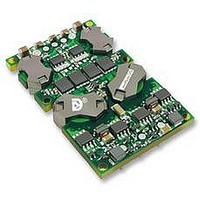UVQ-12/10-D48P-C Murata Power Solutions Inc, UVQ-12/10-D48P-C Datasheet - Page 11

UVQ-12/10-D48P-C
Manufacturer Part Number
UVQ-12/10-D48P-C
Description
DC/DC TH 10A 48-12V Q-Brick
Manufacturer
Murata Power Solutions Inc
Series
UVQr
Datasheet
1.UVQ-1210-D48P-C.pdf
(20 pages)
Specifications of UVQ-12/10-D48P-C
Dc / Dc Converter O/p Type
Single
No. Of Outputs
1
Input Voltage
36V To 75V
Power Rating
120W
Output Voltage
12V
Output Current
10A
Approval Bodies
EN / IEC / UL
Supply Voltage
48V
Rohs Compliant
Yes
Product
Isolated
Output Power
120 W
Input Voltage Range
36 V ot 75 V
Input Voltage (nominal)
48 V
Number Of Outputs
1
Output Voltage (channel 1)
12 V
Output Current (channel 1)
10 A
Isolation Voltage
2.25 KV
Package / Case Size
Quarter Brick
Lead Free Status / Rohs Status
Details
In critical applications, output ripple/noise (also referred to as periodic and
random deviations or PARD) can be reduced below specifi ed limits using fi lter-
ing techniques, the simplest of which is the installation of additional
external output capacitors. Output capacitors function as true fi lter elements
and should be selected for bulk capacitance, low ESR, and appropriate
frequency response. In Figure 3, the two copper strips simulate real-world
pcb impedances between the power supply and its load. Scope measurements
should be made using BNC connectors or the probe ground should be less
than ½ inch and soldered directly to the fi xture.
All external capacitors should have appropriate voltage ratings and be located
as close to the converter as possible. Temperature variations for all relevant
parameters should be taken into consideration. OS-CON
ductor capacitors (www.sanyo.com) can be especially effective for further
reduction of ripple/noise.
The most effective combination of external I/O capacitors will be a function
of line voltage and source impedance, as well as particular load and layout
conditions. Our Applications Engineers can recommend potential solutions and
discuss the possibility of our modifying a given device’s internal fi ltering to
meet your specifi c requirements. Contact our Applications Engineering Group
for additional details.
Start-Up Threshold and Undervoltage Shutdown
Under normal start-up conditions, the UVQ Series will not begin to regulate
properly until the ramping input voltage exceeds the Start-Up Threshold. Once
operating, devices will turn off when the applied voltage drops below the
Undervoltage Shutdown point. Devices will remain off as long as the under-
voltage condition continues. Units will automatically re-start when the applied
voltage is brought back above the Start-Up Threshold. The hysteresis built
into this function avoids an indeterminate on/off condition at a single input
voltage. See Performance/Functional Specifi cations table for actual limits.
Start-Up Time
The V
ramping input voltage crosses the Start-Up Threshold voltage and the point at
which the fully loaded output voltage enters and remains within its speci-
fi ed ±1% accuracy band. Actual measured times will vary with input source
impedance, external input capacitance, and the slew rate and fi nal value of
www.cd4power.com
IN
to V
OUT
+OUTPUT
–OUTPUT
Start-Up Time is the interval between the point at which a
+SENSE
–SENSE
Figure 3. Measuring Output Ripple/Noise (PARD)
®
C1 = 1µF CERAMIC
C2 = 10µF TANTALUM
LOAD 2-3 INCHES (51-76mm) FROM MODULE
7
8
4
5
C1
COPPER STRIP
COPPER STRIP
C2
SCOPE
TM
organic semicon-
R
LOAD
Low-Profi le, Isolated Quarter-Brick 2.5-40 Amp DC/DC Converters
the input voltage as it appears to the converter. The On/Off to V
time assumes that the converter is turned off via the Remote On/Off Control
with the nominal input voltage already applied.
On/Off Control
The primary-side, Remote On/Off Control function (pin 2) can be specifi ed to
operate with either positive or negative polarity. Positive-polarity devices ("P"
suffi x) are enabled when pin 2 is left open or is pulled high. Positive-polarity
devices are disabled when pin 2 is pulled low (0-0.8V with respect to –Input).
Negative-polarity devices are off when pin 2 is high/open and on when pin 2
is pulled low. See Figure 4.
Dynamic control of the remote on/off function is best accomplished with
a mechanical relay or an open-collector/open-drain drive circuit (optically
isolated if appropriate). The drive circuit should be able to sink appropriate
current (see Performance Specifi cations) when activated and withstand
appropriate voltage when deactivated.
Current Limiting
When power demands from the output falls within the current limit inception
range for the rated output current, the DC/DC converter will go into a current
limiting mode. In this condition the output voltage will decrease propor-
tionately with increases in output current, thereby maintaining a somewhat
constant power dissipation. This is commonly referred to as power limiting.
Current limit inception is defi ned as the point where the full-power output
voltage falls below the specifi ed tolerance. If the load current being drawn
from the converter is signifi cant enough, the unit will go into a short circuit
condition. See “Short Circuit Condition.”
Short Circuit Condition
When a converter is in current limit mode the output voltages will drop as
the output current demand increases. If the output voltage drops too low, the
magnetically coupled voltage used to develop primary side voltages will also
drop, thereby shutting down the PWM controller. Following a time-out period of
about 50 milliseconds, the PWM will restart, causing the output voltages to begin
ramping to their appropriate values. If the short-circuit condition persists,
another shutdown cycle will be initiated. This on/off cycling is referred to
as “hiccup” mode. The hiccup cycling reduces the average output current,
thereby preventing internal temperatures from rising to excessive levels. The
UVQ is capable of enduring an indefi nite short circuit output condition.
Figure 4. Driving the Remote On/Off Control Pin
UVQ Series
UVQ Series
OUT
start-up
Page 11 of 20



















